
Last year, I added a new plant to my forest garden – a Siberian pea tree or pea shrub (Caragana arborescens).
In this article, I want to share my reasons for doing so, and let you know why you should consider growing one where you live. Read on to learn what a pea tree is, why you should grow one, and how to do it.
What is a Siberian Pea Tree?
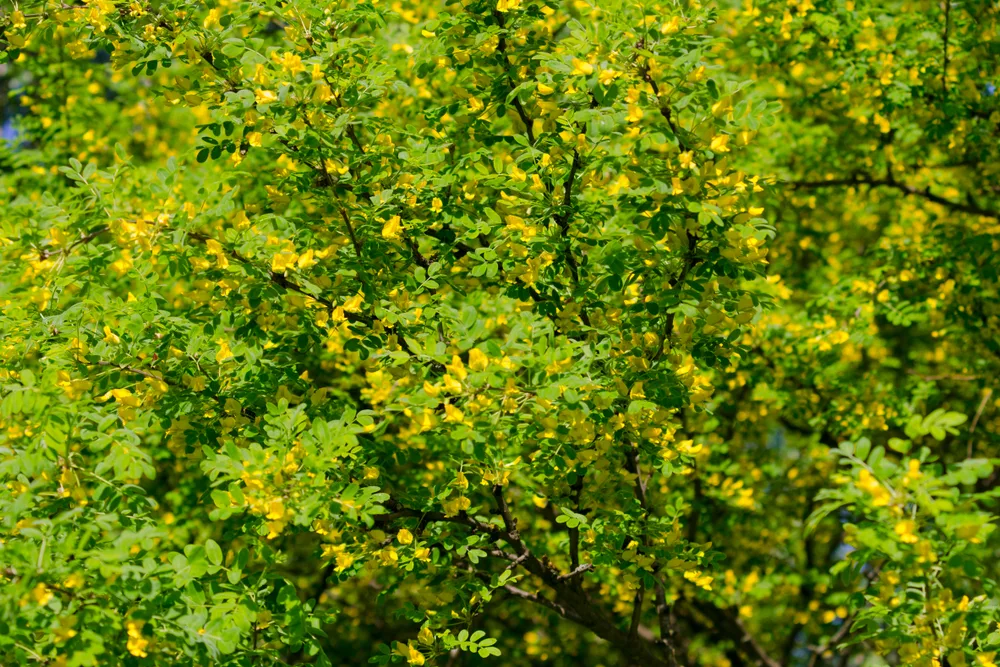
Caragana arborescens is a deciduous shrub or small tree. It’s eventual size will depend on the varietal and on where it is grown.
Native to East Asia, Siberia and Mongolia, it has naturalized in small pockets across Europe and is a popular garden plant both there, and in parts of the United States.
It was introduced to the United States by immigrants, and is considered an invasive plant in some regions. (Its status where you live is something to consider before you consider growing it in your garden.)
In its native range, Siberian pea trees are found along river banks, in open forest and woodland, or on forest edges. It is also found on gully slopes, and stony, steep sites.
While relatively well known as an ornamental garden species in some areas, the Siberian pea tree has become well known in permaculture and organic gardening circles in recent years.
It is commonly used in forest garden design, in perennial polycultures, in agroforestry, agroecology and carbon farming.
Many find it very interesting for its potential in sustainable land management, and as an unusual edible crop (for people, livestock and wildlife).
Why Grow a Siberian Pea Tree?
So why exactly is a Siberian pea tree so useful in sustainable gardening and land management? Why should you consider growing it where you live? What more does it have to offer?
Here are just some of the reasons to consider:
1. For Its Edible Seeds
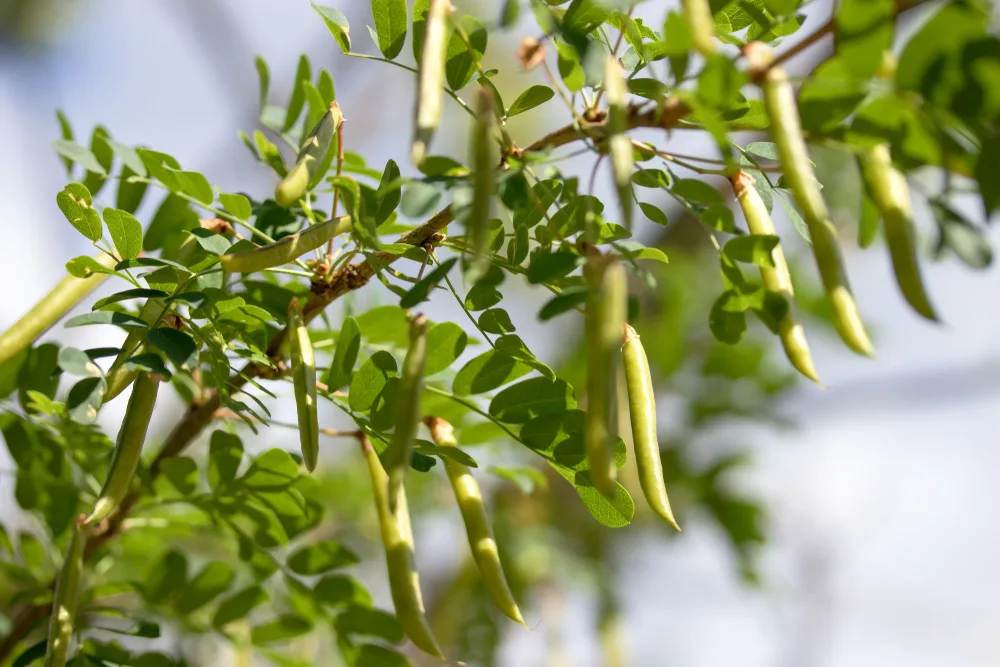
One of the most interesting things about a pea tree is that it has the potential to be more than just a novelty. It may even have the potential to be used as a staple edible crop.
The tree flowers in May/June and by September, the seeds are ripe. Seeds are produced in pods and there are around 4-6 in each one.
The seeds have a mild, pea-like flavor. Eating them raw in any quantity is not recommended. But you can cook and eat the somewhat bland lentil-like seeds in spicy or other flavorsome dishes.
Containing up to 36% protein, these have potential as a healthy and more sustainable alternative to meats, or imported pulses. These seeds have the potential to be an excellent food source. In addition to being eaten as a pulse, the seeds also yield an edible oil.
As well as eating the seeds, you can also cook and eat the young seed pots as a vegetable. The flowers can be eaten raw in moderation in salads and so on. They too have a mild pea-like flavor.
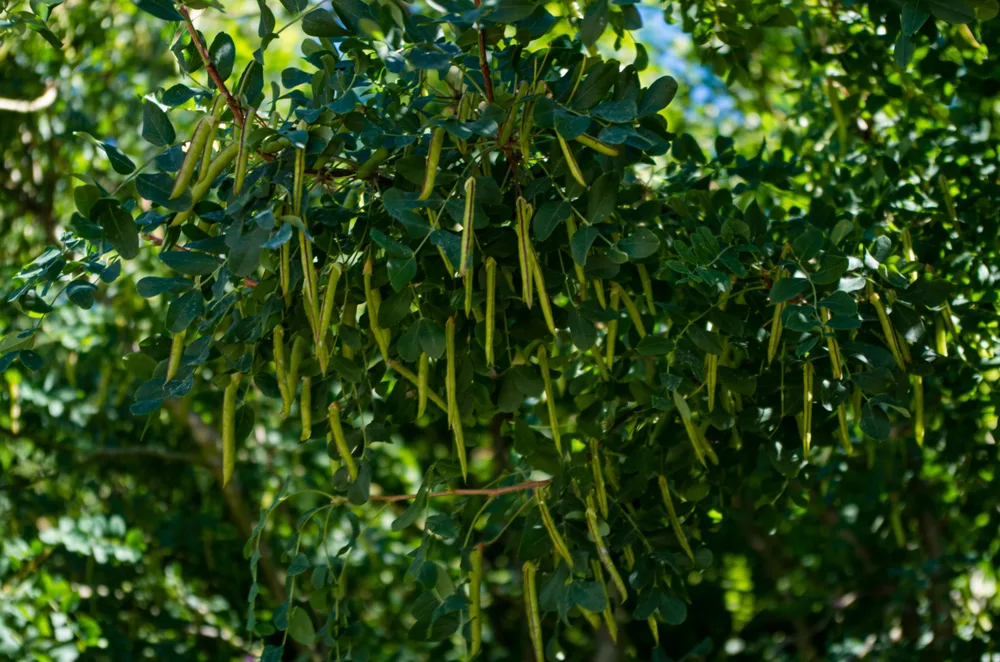
2. As Fodder For Livestock
The pea tree I have planted is in an area foraged by chickens, so in addition to eating some ourselves, we also intend to let some fall for the flock.
Chickens particularly enjoy the pods and seeds of this plant, but it can also be used as a fodder crop for cattle, sheep, goats and other livestock.
3. For Its Nitrogen Fixing Properties, As A Companion Plant
One of the other great things about pea trees or pea shrubs is that they are nitrogen fixers. Like other legumes, they have formed a beneficial symbiosis with bacteria in their root nodules, and can fix atmospheric nitrogen from the air.
Some of the nitrogen is used by the plants, but some enters the surrounding soil where it can potentially be taken up by other plants grown nearby.
Since this plant can thrive even in marginal areas with relatively poor soils, it can be a great pioneer plant – to come in and improve conditions so that other plants can thrive.
Interestingly, this is a nitrogen fixer that can be particularly beneficial in colder climates. Many nitrogen fixers will only perform this function when the soil is warmer, in summer. Nitrogen fixation will often cease when temperatures fall.
But pea trees can fix nitrogen at colder temperatures than most other nitrogen fixers – still performing this function even at around 37.5-41 degrees F..
(This is one of the main reasons that I chose this plant for my cool climate forest garden.)
The Siberian pea tree in my forest garden is part of a wider guild of plants. As a nitrogen fixer, its primary role within this guild is to feed this essential plant nutrient into the system as it grows. Adding nitrogen to the surrounding area that can be taken up by nearby plants.
4. To Improve and Feed Garden Soil
In addition to simply allowing a leguminous plant like a pea tree to fix nitrogen where it stands, you can also use one to improve and feed garden soil in other areas of your garden.
Leaves and cuttings from a Siberian pea tree can be gathered up and added to your composting system, layered as mulch, or simply chopped and dropped to add nutrients to the soil, and to protect it.
5. For Soil Erosion Control
A pea tree won’t just improve soil by adding nutrients. It can also help to create a healthy and resilient soil ecosystem with its extensive root system.
These trees or shrubs can be used to stabilize sloping sites, and to prevent soil erosion and nutrient leaching.
6. To Attract Beneficial Wildlife
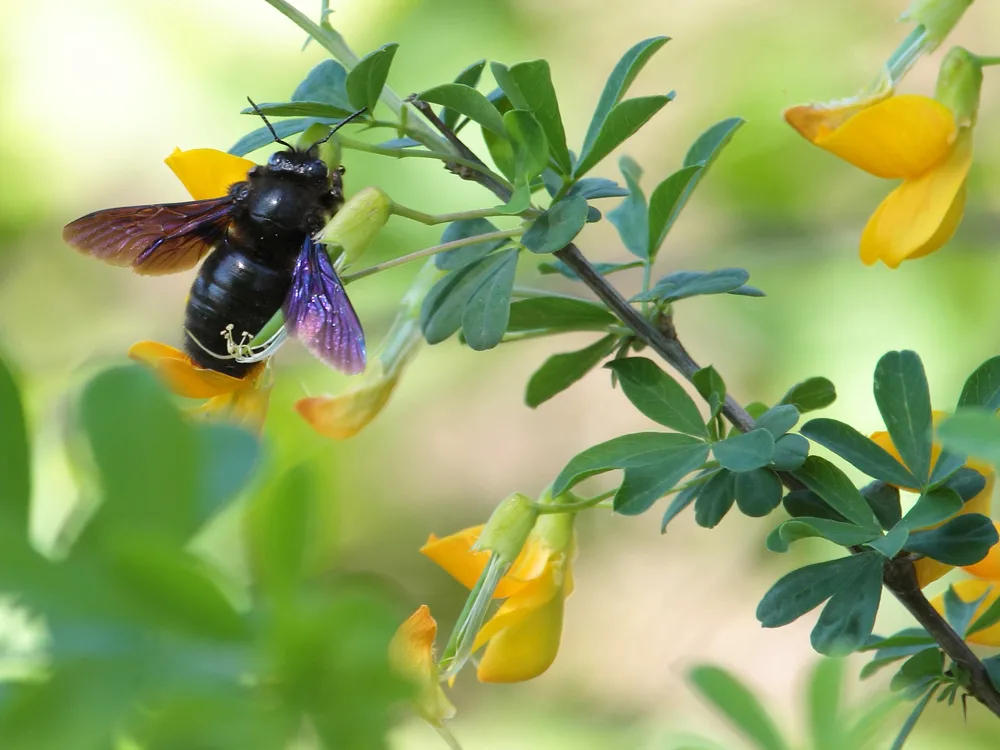
Pea trees are also great because they attract beneficial wildlife to your garden. The flowers attract bees and other pollinators in the spring/ early summer.
These trees or shrubs are also said to attract beneficial predatory insects such as lacewings and parasitic wasps that can help keep pest numbers of aphids etc. in check. And hummingbirds also like the nectar.
7. As a Wind Break or As Part of a Shelter Belt
Siberian pea trees can be very useful in a challenging locale, such as a windy site. They can effectively be used as part of a wind break hedgerow, living fence, or shelter belt in a range of different locations and soil conditions.
8. For Its Oil (For Use in Soap Making, Paints Etc.)
The oil derived from the seeds of pea trees cannot only be used for edible applications. It can also potentially be used in soap making, paint making, or the making of natural lubricants.
9. For Bark Fibre
The bark of these trees or shrubs also yields a useful plant fibre. This can be used to make cordage, for paper making, or in a number of other ways to boost self-reliance on your homestead.
10. To Make a Natural Blue Dye
The leaves of the Siberian pea tree also yield a beautiful azure dye. You can use this on natural fabrics as an alternative to damaging synthetic options.
11. As a Traditional Chinese Herbal Medicine
The pea tree is also traditionally used in herbal medicine. It is said to be beneficial for treatment of breast cancer. And also in the treatment of dysmenorrhoea and other menstrual problems by increasing/improving blood flow to the pelvic region of the body.
12. For its Ornamental Value
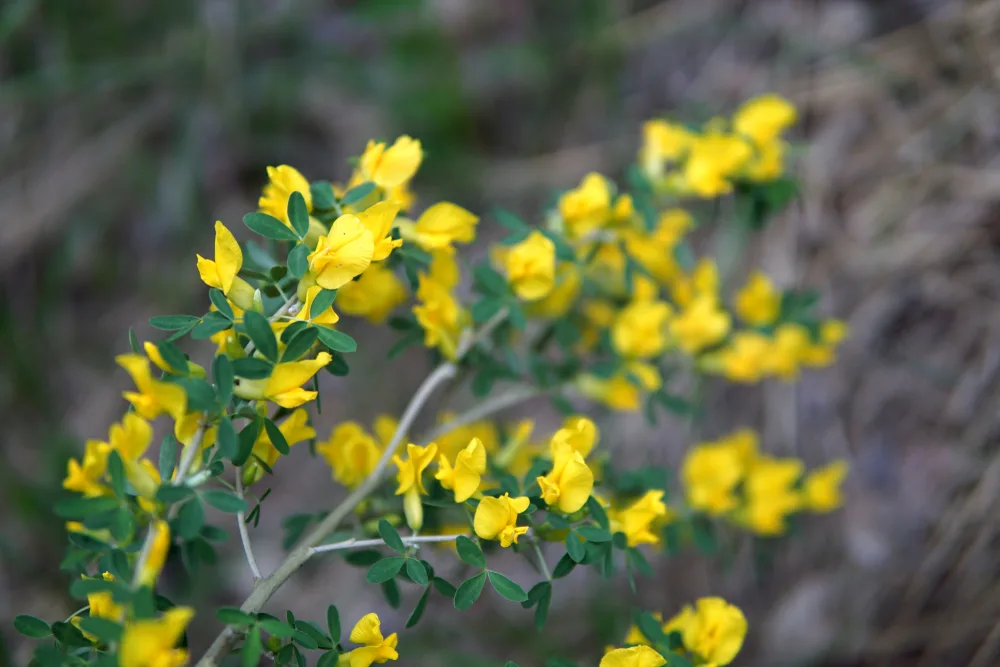
A Siberian pea tree will grow in a huge range of settings. So you can use it ornamentally in many widely different gardens.
The Siberian pea tree is so useful that it might be easy to overlook the fact that it is also a very visually attractive plant.
This plant has attractive and rather unusual light green leaves that make it stand out amid other tree and plant species. The bright yellow flowers that bloom in May/June are also very appealing. Over summer, the interest continues with the long seed pods dangling from the tree or shrub.
If you are growing a Siberian pea tree primarily for its ornamental value then there are a few different forms you can consider. Most Siberian pea trees or pea shrubs are standards with a multi-stemmed habit. But there are varietals which offer particular shapes and forms.
‘Nana’ is a very compact dwarf form, for example, which grows slowly. There are also weeping forms, whose branches are more pendulous and bend back down more towards the ground. Which cultivar you select will determine whether your plant is more tree or shrub in form and habit.
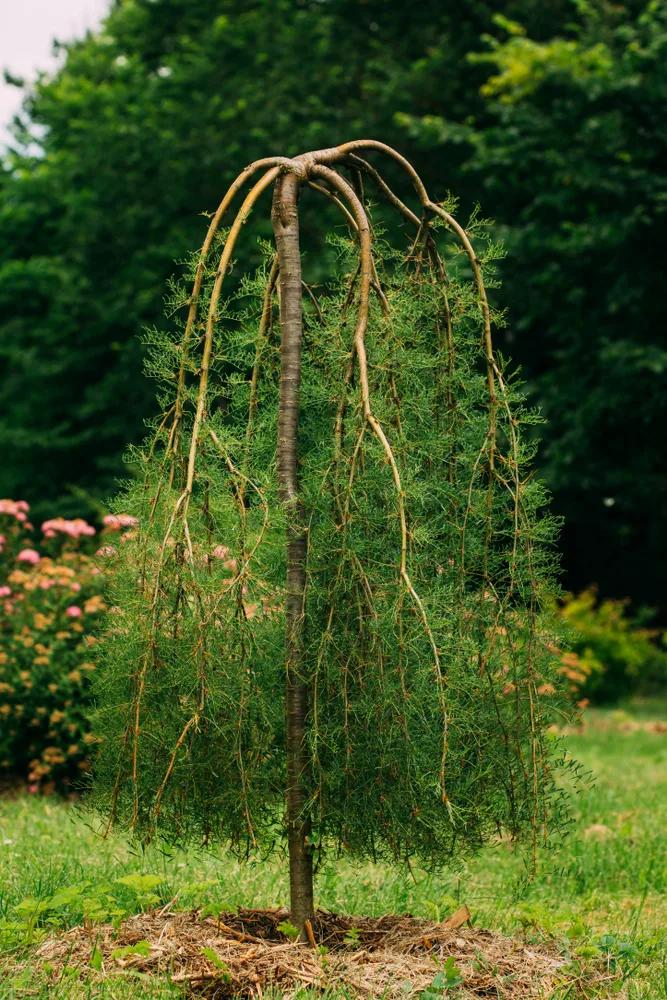
Siberian Pea Tree Grow Guide
By now, you should have a much clearer idea about why you should grow a Siberian pea tree. So let’s next turn our attention to how to grow one.
Where to Place a Siberian Pea Tree
Siberian pea trees are incredibly hardy and tough plants. They can survive in areas with nutritionally poor soil, as long as it is relatively free-draining and does not become too waterlogged in the winter months.
It will do best in lighter sandy or loamy soils. And it can even cope with neutral, alkaline or even very alkaline soils. These trees can tolerate droughts, and strong winds, and are hardy down to around minus 22 degrees Fahrenheit.
However, it is important to note that the young foliage on the pea tree in spring, even on mature plants, is frost-tender. So you should grow the plants in a position where they are not in a frost pocket, and are sheltered from the early morning sun.
The plant is heat tolerant to a degree, and you can grow it in areas with warm to hot summers. However, it does also require a period of winter cold, and will not thrive where winters are too mild.
Siberian pea trees can find a place in a range of locations within a garden. They work well in forest garden schemes, as ornamental single trees, or, as mentioned above, as part of shelter belts or wind break hedges on your property.
Sowing a Siberian Pea Tree
There are two options when it comes to growing a Siberian pea tree or shrub.
You can sow your pea tree from seed, or you can purchase a sapling or even a larger tree to transplant into your garden.
Sowing a Siberian pea tree is, of course, a far cheaper option. But it is worth bearing in mind that if you sow from seed, it will be around 3-5 years before your tree begins to crop.
You may be able to purchase a Siberian pea tree sapling at your local plant nursery or at a specialist online plant nursery. Nature Hills is our recommended supplier and they offer this Siberian peashrub for sale.
Siberian pea tree seeds are readily available from a range of suppliers online. But when choosing seeds, it is best to choose those from a reputable supplier, ideally based as close to you geographically as possible.
Gardeners sow the seeds in spring. Before sowing them, you should scarify and soak them, to improve the chances of successful germination. Indoors, at a temperature of around 68 F., seeds should germinate in around 2-3 weeks.
It is best to sow them into a dedicated seed bed, or into pots or containers rather than direct sowing where they are to grow. Sow the seeds at a depth of around 1 inch, into a moist yet free-draining growing medium.
If you allow the seeds to disperse, and reach the soil, new saplings will often spring up around the base of the existing plant.
Planting a Siberian Pea Tree
If you would rather get a harvest more quickly, and avoid the hassle of growing from seed, then you can consider buying a Siberian pea tree.
You can purchase a bare-root plant in fall to sow over the dormant months, or purchase (more expensively) a pot grown plant at any time of year.
I purchased a bare root plant last fall. It rooted and established itself well over winter. And I have been delighted to see the new foliage emerge this spring.
When planting out a Siberian pea tree, whether you have grown it from seed, or purchased one that is already a couple of years old, you should be careful to make sure the soil comes up to the same point on the trunk as it did before. Simply make a hole large enough to accommodate the roots, spread them out, then cover back with soil, firming it into place.
Caring For a Siberian Pea Tree
Siberian pea trees do not require a lot of care. So they can be a great choice for a low maintenance garden.
You can, if you wish, train or prune the trees or shrubs to make more pleasing shapes or forms or to keep your pea tree to a particular size. If left to their own devices, some varietals will grow to up to 20ft or so in height, and around 12ft in width. Though most examples are quite a lot smaller, or can be kept so.
As mentioned above, you can add the pruned material (and fall leaves) to a compost heap or use these as mulch – locally, or in other parts of your garden.
Reasonably drought tolerant, pea trees will seldom require additional watering in most climate zones where they grow. However, in very dry areas, you may need to water during the initial stages as the plant establishes itself.
Harvesting
As mentioned above, you can add the flowers that emerge in spring to salads for a mild, pea-like flavor. But leave most flowers on the tree, and the pods will develop.
You can cook and eat some of the pods as a green vegetable. Leave most to develop, however, and in around August/September, you will be able to harvest the seeds.
Pick green seeds to eat like peas, or wait a little longer to harvest fully mature seeds to use as a pulse, like lentils.
Harvest the seeds for drying when the pods have dried out but before the pods split and pop open and the seeds fall to the ground. Pick the pods and leave them to dry before popping open the brittle pods and gathering the seeds.
Siberian pea trees really are a great value plant. Buy some seeds, or a sapling, and you should have a supply of plenty more seeds.
You can not only use these as food for you or your livestock to eat. You can also sow them in future years. So why not consider growing one (or more) in your garden?

Get the famous Rural Sprout newsletter delivered to your inbox.
Including Sunday musings from our editor, Tracey, as well as “What’s Up Wednesday” our roundup of what’s in season and new article updates and alerts.


